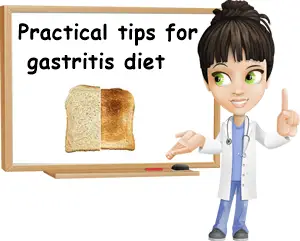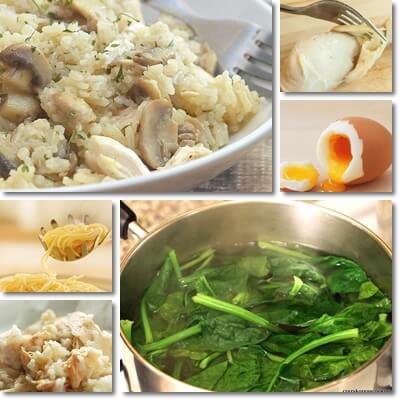Even when you know what foods to eat and what foods to avoid for gastritis, it’s often difficult to figure out how to eat them. I mean, what is the right proportion of each? How do you avoid constipation because of the lack of fiber? How do you avoid not eating too much fiber in the first place? And what do you do about the almost unavoidable nutrient deficiencies that arise from restrictive gastritis diet? How much is too much food and how do you keep meals satiating when there is so little to choose from? This is what today’s article is all about: learning how to eat for gastritis.
The main reason why a lot of people can’t seem to manage their gastritis no matter what is because they fail at eating right. It takes one bad food to set you back a week. It takes feeling better after a few days of eating right to get you reverting back to bad eating habits and overturning your progress. It takes believing there is no effort from your part required to treat gastritis, just medication, to not even try and have the condition worsen. It takes taking too long to get it right to, well, live with gastritis for too long and suffer the increasingly more difficult to revert side effects and habits.

Eating for gastritis is frustrating, to say the least. There are few food options, everything tastes bland, you can’t eat what you like because most of the foods you like have some sort of side effect. And if you’re making even one small mistake, like eating oatmeal every morning, or drinking green tea or having a glass of orange juice a couple of times, then there will be very little progress, or none at all, which will have you wondering why it isn’t working since you’re doing what you’re supposed to be doing, following every advice you’ve been given or trying everything others have been trying. The truth with eating for gastritis is that you have to do everything right or else you will not the see the progress you should be seeing.
And this includes not changing up your diet based on what you may hear or read. As much as we’d all want, there is nothing fun about eating for gastritis. It’s boring, you will get sick of it and dream about what it feels like to be able to enjoy just one hot cup of coffee, one glazed doughnut or two cubes of chocolate. More important, the foods that are otherwise extremely healthy for you are likely bad for you gastritis. This is the hardest truth to accept and where most people fail at when it comes to eating right for gastritis. Here are the 11 golden rules to follow if you want to cure your gastritis naturally:
1) Rethink the way you look at food
When eating for gastritis you have to understand that the concept of healthy food morphs into something new. Garlic is no longer good in gastritis, nor are broccoli or yogurt. You have to stop thinking about food as healthy in the traditional way and start seeing it as healthy for your gastritis only. What does gastritis respond to? Treating gastritis requires bland, absorbent foods, little dietary fiber, enough protein and simple carbohydrates. And while this is not healthy in the long run, it will allow for the gastritis to be healed so you can resume the real healthy eating.
2) Allowed foods
So what can you eat when you have gastritis? You can eat refined grains such as white rice, white bread, toast, plain crackers and bagels, pita bread (pocket bread or unleavened flat bread) from refined flour or polenta from maize flour. You can eat tuberous vegetables like potatoes (but maybe not sweet potatoes), carrots, celeriac (celery root – check for allergies), parsnip. You can eat spinach because it’s mucilaginous when cooked and somehow doesn’t trigger gastritis symptoms, but always mix the vegetables with some absorbent food. Mushrooms are debatable, but if they don’t cause stomach upset, they can be a good food to eat once or twice a week, with spaghetti or rice. Parsley is okay.

You can eat chicken meat (without liver) and white turkey meat, occasionally lean fish like cod or aurata. You can maybe eat a ripe banana, golden throughout, with tiny, brown spots. You can maybe eat a stewed apple or pear, without skin, or a stewed quince. You can have a little raw honey of your choice on toast, but check for allergies first. But try to avoid fruits the first week if your gastritis is bad and then slowly introduce them, eating no more than one cooked fruit (except for bananas which you can have raw) every couple of days. A tablespoon of olive oil or other cold pressed oil of your choice may be added fresh to food, but not used for frying.
3) Eat everything boiled or steamed
These two cooking methods help break down food nicely and make it easier on the stomach, allowing for the food to be digested easily. Moreover, cooking your food this way ensures you don’t add oils, butter or grease which could worsen gastritis symptoms and adds a good deal of moisture to your food, which is beneficial too. Everything except for the ripe bananas can be boiled or steamed. Grilling or roasting without oil or grease are also good options.
4) Puree food
If your gastritis is as worse it it gets, it could help to puree food. Everything from pasta to plain boiled chicken and eggs can be pureed in a food processor. Why do this? Well, pureed food can be considered halfway digested, which means your stomach will put even less effort in digesting it which will help with the recovery. Alternatively, you can get jars of ready-to-eat baby food, but make sure it contains only allowed foods.
5) Enjoy simple, easy meals
The goal is to help your stomach digest food easier. So in addition to boiling and pureeing food, you can eat 2-3 foods during one meal. For example, you can have 2 soft boiled eggs in the morning with toast. At lunch you can have chicken with rice and maybe two carrots. At dinner you can have spaghetti with mushrooms (boiled champignon or portobelo mushrooms, pureed in a food processor, with a tablespoon of fresh olive oil and salt). It’s really about simplicity and eating fewer foods during the same meal can really make a difference for your stomach. See more food choices in my 1 week gastritis diet plan.
6) Eat small meals often
Ideally, don’t fill up on food or starve yourself. You can achieve a balanced eating by filling half your plate with food, using a smaller plate or even a children’s food bowl if it’s easier for you, then eat when you’re feeling hungry again. Eating small meals often helps the stomach only have to deal with proportionate amounts of food at once so it’s not overwhelmed. This should help reduce acidity and the sensation of feeling full after having only a few bites of food.
7) Combat gastritis bloating
A lot of people with gastritis experience bloating. In my case, the bloating was caused by fluids rather than food. So it helped to avoid drinking water during a meal, unless I really had to. I would drink water at least half an hour before eating and at least half an hour after a meal. For those with bloating from food, keeping to allowed foods and eating small meals often can help.
8) Combine foods wisely
For when gastritis is at its worst, eating one absorbent food at every meal can really help reduce symptoms. If you are experiencing stomach upset from eating too much fiber, you can try to exclude one food that is also a source of fiber from your diet and see if that helps. For example, if you’ve eaten only chicken with a few carrots at lunch, had a banana or stewed apple as a snack, then again chicken with spinach and the next day you feel your gastritis acting up again, you can try to replace one vegetable in a meal with something more absorbent like rice or pasta or a bagel or instead, give up a fruit snack.
9) Combat constipation
The problem with eating for gastritis is that you might not get enough fiber and this can lead to constipation. As soon as you notice the first signs of constipation, take control of your diet and change something. For example, you can have half an avocado in the morning (if it’s not a problematic food for you) to get some fat to easy stools passing and soften them. You can have a simple chicken noodle soup at lunch, only from “allowed” or gastritis-friendly ingredients, to get more fluids into your diet and a little more fiber from the allowed vegetables. Eat a stewed apple or a ripe banana as a snack and see how this helps you. Balance your eating according to your individual needs. Drink more water or have a tea that doesn’t bother your stomach to help relieve constipation (read more about what foods to eat and to avoid for gastritis).
10) Supplement with a multivitamin
A good diet (you really keep to) can cure your gastritis in two weeks. Or it can take three months. When you’re on a restrictive diet for too long, it might be best to consider a multivitamin to get the nutrients you might be missing from food. Generally, tablets are better because effervescent vitamins can cause acid reflux and worsen your condition. Make sure the multivitamin has plenty of B vitamins, even though you’re getting good amounts, especially of B12 and B9 from eggs and chicken meat. You need B vitamins to counteract fatigue and support digestion. Get a multivitamin with good amounts of magnesium, potassium, iron, calcium, phosphorus, selenium, zinc, vitamins A, C and E. Take your vitamins 4 hours before your gastritis medication, or 4 hours after, but always after a good meal to increase absorption.
11) And the most important rule
If you don’t feel good after eating a certain food, exclude it from your diet. It doesn’t matter if it’s good for others, what matters is that it’s not good for you and you don’t need to experience the side effects of a problematic food on top of the gastritis symptoms. At least in this respect, gastritis diet guidelines are flexible. Other than this, persevere in your good eating habits, even when you don’t see immediate changes, do not give into bad habits when you do see improvements quickly, keep only foods you’re allowed to eat in the house if possible and continue eating right even after you feel well again. Only after you’ve healed you may slowly start introducing other foods into your diet, one by one. This is how you eat for gastritis.
